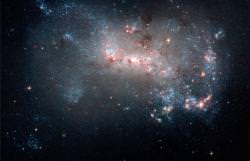This latest image released from the Hubble Space Telescope shows the dwarf galaxy NGC 4449, located about 12.5 million light-years away. Although the galaxy has been around for billions of years, it recently went through a period of intense star formation.
Most starburst galaxies concentrate their stellar formation around the crowded galactic core, but in NGC 4449, the active regions extend out across more of the galaxy. This will only last for another billion years or so, when the gas supply that feeds the star forming regions runs out. It will then stay quiet until it has a close encounter with another galaxy, starting the process all over again.
A galaxy like NGC 4449 resembles what the first primordial galaxies probably looked like, formed shortly after the Big Bang when the Universe was young. Many small galaxies merged together forming larger and larger galaxies until they became the majestic spirals we see today. Each new merger brings in a fresh supply of raw materials as well as the gravitational interactions to force gas clouds to collapse.
Original Source:Hubble

